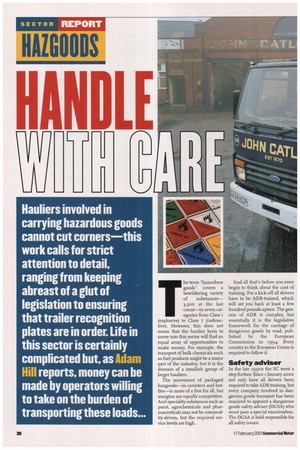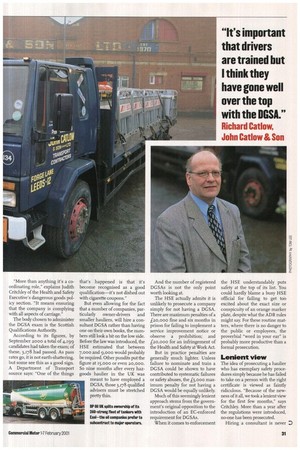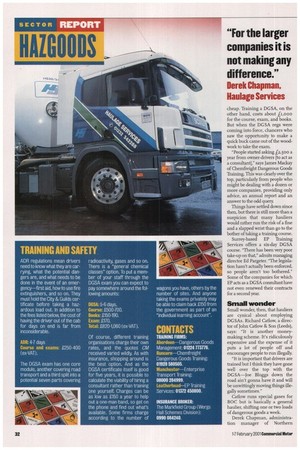T he term "hazardous goods" covers a bewildering variety of substances3,500
Page 32

Page 33

Page 34

Page 35

If you've noticed an error in this article please click here to report it so we can fix it.
at the last count—in seven categories from Class I (explosive) to Class 7 (radioactive). However, this does not mean that the haulier keen to move into this sector will find an equal array of opportunities to make money. For example, the transport of bulk chemicals such as fuel products might be a major part of the industry, but it is the domain of a smallish group of larger hauliers.
The movement of packaged hazgoods—in canisters and bottles—is more of a free for all, but margins are equally competitive. And speciality substances such as paint, agrochemirals and pharmaceuticals may not be commodity-driven, but the required service levels are high. And all that's before you even begin to think about the cost of training. For a kick-off all drivers have to be ADR-trained, which will set you back at least a few hundred pounds apiece. The genesis of A DR is complex, but essentially it is the legislative framework for the carriage of dangerous goods by road, published by the European Commission in 1994. Every country in the European Union is required to follow it.
Safety adviser
In the late 1990s the EC went a step further. Since 1 January 2000 not only have all drivers been required to take ADR training, but every company involved in dangerous goods transport has been required to appoint a dangerous goods safety adviser (DGSA) who must pass a special examination. The DGSA is held responsible for all safety issues.
"More than anything it's a coordinating role," explains Judith Critdlley of the Health and Safety Executive's dangerous goods policy section. "It means ensuring that the company is complying with all aspects of carriage."
The body chosen to administer the DGSA exam is the Scottish Qualifications Authority.
According to its figures, by September 2000 a total of 4,199 candidates had taken the exam; of these, 3,178 had passed. As pass rates go, it is not earth-shattering, but some see this as a good sign. A Department of Transport source says: "One of the things
that's happened is that it's become recognised as a good qualification—it's not dished out with cigarette coupons."
But even allowing for the fact that a number of companies, particularly owner-drivers and smaller hauliers, will hire a consultant DGSA rather than having one on their own books, the numbers still look a bit on the low side. Before the law was introduced, the HSE estimated that between 7,000 and 9,000 would probably be required. Other pundits put the figure at 15,000 or even 20,000. So nine months after every hazgoods haulier in the UK was meant to have employed a DGSA, those 3,178 qualified advisers must be stretched pretty thin.
And the number of registered DGSAs is not the only point worth looking at.
The HSE actually admits it is unlikely to prosecute a company simply for not having a DGSA. There are maximum penalties of a £20,000 fine and six months in prison for failing to implement a service improvement notice or observe a prohibition; and £20,000 for an infringement of the Health and Safety at Work Act.
But in practice penalties are generally much lighter. Unless failure to nominate and train a DGSA could be shown to have contributed to systematic failures or safety abuses, the £5,000 maximum penalty for not having a DGSA would be equally unlikely.
Much of this seemingly lenient approach stems from the government's original opposition to the introduction of an EC-enforced requirement for DGSAs.
When it comes to enforcement the HSE understandably puts safety at the top of its list. You could hardly blame a busy HSE official for failing to get too excited about the exact size or conspicuity of an orange marker plate, despite what the ADR rules might say. For these routine matters, where there is no danger to the public or employees, the proverbial "word in your ear" is probably more productive than a formal prosecution.
Lenient view
The idea of prosecuting a haulier who has exemplary safety procedures simply because he has failed to take on a person with the right certificate is viewed as faintly ridiculous. "Because of the newness of it all, we took a lenient view for the first few months," says Critridey. More than a year after the regulations were introduced, no-one has been prosecuted.
Hiring a consultant is never cheap. Training a DGSA, on the other hand, costs about ir,000 for the course, exam, and books. But when the DG SA regs were coming into force, chancers who saw the opportunity to make a quick buck came out of the woodwork to take the exam.
"People started asking i2,5oo a year from owner-drivers Ito act as a consultant]," says James Mackay of Chemfreight Dangerous Goods Training. This was clearly over the top, particularly from people who might be dealing with a dozen or more companies, providing only advice, an annual report and an answer to the odd query.
Things have settled down since then, but there is still more than a suspicion that many hauliers would rather run the risk of a fine and a slapped wrist than go to the bother of taking a training course.
Surrey-based EP Training Services offers a six-day DGSA course. "There has been very poor take-upon that," admits managing director Ed Pargeter. "The legislation hasn't actually been enforced, so people aren't too bothered." Some of the companies for which EP acts as a DGSA consultant have not even renewed their contracts for a second year &nal wonder Small wonder, then, that hauliers are cynical about employing DGSAs. Richard Catlow, a director of John Catlow & Son (Leeds), says: "It is another moneymaking scheme. It's ridiculously expensive and the expense of it puts a lot of people off and encourages people to run illegally.
"It is important that drivers are trained but I think they have gone well over the top with the DGSA—Joe Bloggs down the road ain't gonna have it and will be unwittingly moving things illegally sometimes."
Catiow runs special gases for HOC but is basically a general haulier, shifting one or two loads of dangerous goods a week.
Derek Chapman, administration manager of Northern Ireland-based Haulage Services, understands the DGSA scheme but questions its validity: "You are moving the safety function from a quality manual to a dangerous goods manual.
"I see the logic, but it all seems to be written to inspect the guys who are doing it properly. I have yet to hear of one company that has been stopped. It is legislation for the sake of legislation, almost—for the larger companies it is not making any difference at all."
As legislation increases, the number of companies to which it applies seems to be falling. Although the dangerous goods sector itself is not in decline, companies are certainly leaving it.
Dangerous goods
Peter Newport, divisional general manager at P&O Trans European, says: "The requirement of the DGSA and increasing complexity of legislation has meant that the dangerous goods industry is becoming more specialised. Occasional carriers have moved Out, thinking 'Is this worth it? Do we get a payback?'."
Chris MacRae, the Freight Transport Association's training and policy manager for dangerous goods, agrees: "It is becoming more specialist. If you're a general haulier you have to look very carefully at revenues. Operators who used to dabble now just don't."
This is certainly the experience of TW Devanney & Sons. Ten years ago, half of its business involved the transport of danger
ous goods. Now it accounts for less than io% and this is an area the company is doing its best to steer clear of, although it has a consultant DGSA.
"Customers don't want to pay any extra," says director Stephen Devanney. "Insurance goes up and the rates are the same as you get for doing dry freight or groupage." Devanney still runs packaged chemicals to France and Germany but adds that it can take half a day longer with a hazardous load, because all ferries can carry them, and there are tighter speed limits and load restraints. It is worth remembering that C-i-E drivers with A DR— especially experienced ones—are relatively rare so their services can be at something of a premium.
Like virtually any other commodities, hazardous goods are prone to seasonal fluctuations.
For example, transport of agrichemicals will be busy in spring; sodium hydrochloride (bleach) peaks in summer when people want their swimming pools treated; heating fuel and fertiliser are likewise linked to different times of the year.
Sizeable though the market is, it is not necessarily all that attractive for the newcomer because opportunities for subcontracting are limited in many areas. Oil companies do subcontract some. or even most, of their work but it tends to be to large players—BP Oil UK, for example, splits ownership of its 240-strong tanker fleet 50-5o with Exel.
For the dangerous goods haulier there are always develop ments to keep abreast of, too. The process of education is ongoing: new versions of ADR regulations are framed every two years, with the next batch due this summer.
Far from being a cause for operator concern, the HSE insists that the new rules will contain little material change, and promises that they will be easier to navigate. These regs will be implemented on i January 2003.
Important factor
In addition to legislation, opportunity and training, another important factor to consider is the fact that the majority of insurers are simply not comfortable with the hazardous goods sector.
Norwich Union is an exception to this rule, and says it is happy to cover hauliers at regular terms on receipt of the correct certification. But others will increase your premiums substantially to take account of the extra perceived risk.
Theft of loads is rarely a problem with dangerous goods— unlike, say, TVs or whisky—so load insurance is likely to carry either just a small increase in premium or an additional excess. But be prepared for a lot of questions about your procedures, and remember that in this sector an insurer is likely to walk away from a haulier it considers inexperienced.
Dangerous goods is a potentially exciting catch-all sector ranging from fireworks to paint. But rates are competitive, investment in training and equipment is high, and the legislation is bound to get tighter.
And as the ETA's Chris MacRae says: "If it's something you're doing as an add-on, it's probably not worth your while." The bottom line is that wise hauliers will do some very careful sums before taldng the plunge.
































































































